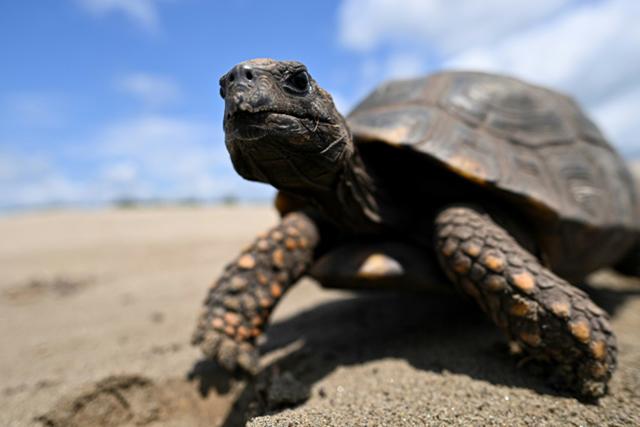You are here
Fossil reveals burrowing lifestyle of tiny dinosaur-like creatures
By AFP - Sep 11,2021 - Last updated at Sep 11,2021

Artist rendition of a microsaur, a finger-sized fossil from 308 million years ago unearthed in the United States (AFP photo)
PARIS — A finger-sized fossil from 308 million years ago unearthed in the United States gives tantalising clues to the habits of tiny dinosaur-like creatures that may be the forerunners of reptiles, researchers recently revealed.
The new species is a microsaur — small, lizard-like animals that roamed the Earth well before proper dinosaurs made their appearance.
The find sheds important light on the evolution of different animal groups, including amphibians and reptiles, scientists wrote in the journal Royal Society Open Science.
Microsaurs lived during the Carboniferous period, when the forebears of modern mammals and reptiles, called amniotes, first appeared.
“Many details of that transition aren’t well known,” study co-author Arjan Mann, a post-doctoral research fellow at the Smithsonian Institution, told AFP.
“Microsaurs have recently become important in understanding the origins of amniotes,” he said. “A lot of these microsaurs have been thought to be either ancestors of amphibians or ancestors of reptiles.”
Encased in a bog in what is today the central United States, the specimen’s serpent-like body measures about five centimetres.
The animals had four short, plump legs.
In deference to its tiny size, researchers dubbed the new species Joermungandr bolti after a giant sea serpent from Norse mythology who did battle with Thor.
Scientists were astonished to discover the fossil also contained the animal’s skin.
“Areas of the skin had only been known from fragmentary fossils before,” said Mann.
“This microsaur is the whole shebang... that’s very rare for these fossils. It’s very rare for anything 300 million years old to have skin with it!”
Head-first burrower
Contrary to previous ideas about microsaurs, which had been classed as amphibians, Mann and his team discovered that Joermungandr had scales.
“Modern amphibians... are soft and slimy things, this was not a soft and slimy thing,” says Mann.
“This animal really had a reptile-like look to it.”
Mann said the research suggests not only that microsaurs might be early relatives of reptiles, but also that the ability to burrow may have played a bigger role in the origin of amniotes than originally thought.
The researchers used a highly sensitive imaging technique called scanning electron microscopy (SEM) to get an up-close look at the nearly perfect fossil.
They discovered a pattern of ridges similar to those found on the scales of modern reptiles that dig into the ground.
Along with other features like a robust skull and elongated body, the scale shape led researchers to hypothesise that Joermungandr burrowed as well.
“It would probably have been a head-first burrower, using its head to smack itself into the soil,” said Mann.
“Its limbs were probably not very functional. It may have used them to stabilise itself as it was wobbling around. But its primary mode of movement would have been side winding like a snake.”
The SEM imaging technique is now being applied to many other ancient fossils, Mann said.
“We plan to do a lot of SEM and also 3-D printing the scales at larger sizes,” he added. “And some biomechanics to see how they interacted with things like dirt and water.”
Related Articles
Pets that visit nursing homes or live there with a resident can be a benefit to all, but administrators also need to consider possible risks
PARIS — The Chinese giant salamander, the largest amphibian in the world, is not cute. Weighing as much as an adult human, it has slimy
PARIS — At least one in five reptile species are threatened with extinction, including more than half of turtles and crocodiles, according t
Opinion
Nov 03, 2023
Nov 03, 2023
Nov 01, 2023
- Popular
- Rated
- Commented
Nov 03, 2023
Nov 03, 2023
Oct 31, 2023
Nov 03, 2023
Newsletter
Get top stories and blog posts emailed to you each day.
















